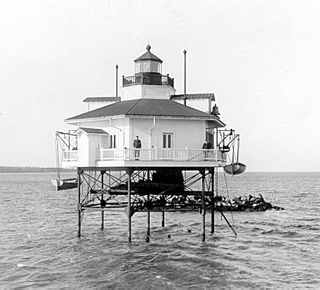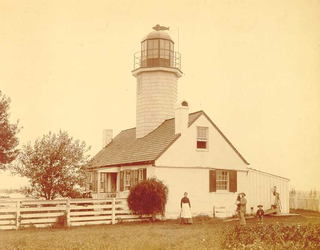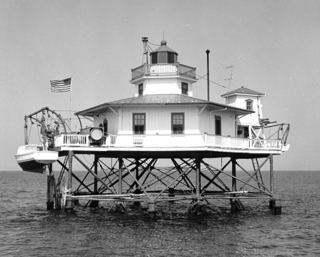
A screw-pile lighthouse is a lighthouse which stands on piles that are screwed into sandy or muddy sea or river bottoms. The first screw-pile lighthouse to begin construction was built by the blind Irish engineer Alexander Mitchell. Construction began in 1838 at the mouth of the Thames and was known as the Maplin Sands lighthouse, and first lit in 1841. However, though its construction began later, the Wyre Light in Fleetwood, Lancashire, was the first to be lit.

The Seven Foot Knoll Light was built in 1855 and is the oldest screw-pile lighthouse in Maryland. It was located atop Seven Foot Knoll in the Chesapeake Bay until it was replaced by a modern navigational aid and relocated to Baltimore's Inner Harbor as a museum exhibit.

The Thomas Point Shoal Light, also known as Thomas Point Shoal Light Station, is a historic lighthouse in the Chesapeake Bay on the east coast of the United States, and the most recognized lighthouse in Maryland. It is the only screw-pile lighthouse in the bay which stands at its original site. The current structure is a 1½ story hexagonal wooden cottage, equipped with a foghorn as well as the light.

The Holland Island Bar Light was a screw-pile lighthouse in the Chesapeake Bay which existed from 1889 to 1960. It is remembered for the unexplained death of one of its keepers, and for being "attacked" by United States Navy pilots during a training exercise.

The Mathias Point Light was a screw-pile lighthouse in the Potomac River in Maryland; the station was located near the Port Tobacco River. It was particularly noted for its ornate woodwork.

The Sharps Island Light is the third lighthouse to stand nearly 3 miles (5 km) south-southwest from the southern end of Tilghman Island in Maryland's Chesapeake Bay. The structure is best known today for evoking the Leaning Tower of Pisa, a condition caused by an ice floe in 1977.

Solomons Lump Light is a lighthouse in the Chesapeake Bay, the abbreviated remains of a caisson light built in 1895. That structure replaced a screw-pile light built on the same spot in 1875, which in turn superseded the Fog Point Light.

Bloody Point Bar Light is an early sparkplug lighthouse in the Chesapeake Bay near Kent Island, Maryland.

The Ragged Point Light was a screw-pile lighthouse located in the Potomac River. It was the last lighthouse built in Maryland waters and the last built at a location in the Chesapeake Bay.

The Cove Point Light is a lighthouse located on the west side of Chesapeake Bay in Calvert County, Maryland.
The Sharkfin Shoal Light was a screw-pile lighthouse located at the mouth of the Nanticoke River in Chesapeake Bay, US.
The Clay Island Light was a historic lighthouse located on Clay Island at the mouth of the Nanticoke River on the Chesapeake Bay. Constructed in 1832, it continued to serve the area until 1892, when it was replaced by the Sharkfin Shoal Light. Two years later, the building collapsed, and nothing remains of it.

Greenbury Point Light was the name of two lighthouses in the Chesapeake Bay, both located at the mouth of the Severn River in Annapolis, Maryland.

Love Point Light was a screw-pile lighthouse in the Chesapeake Bay, off the northern end of Kent Island, Maryland.

Hooper Strait Light is one of four surviving Chesapeake Bay screw-pile lighthouses in the U.S. state of Maryland. Originally located in Hooper Strait, between Hooper and Bloodsworth Islands in Dorchester County and at the entrance to Tangier Sound, it is now an exhibit at the Chesapeake Bay Maritime Museum in St. Michaels, Maryland.
The Janes Island Light was a screw-pile lighthouse located near Crisfield in the U.S. state of Maryland. Twice destroyed by ice, it was replaced in 1935 with an automated beacon.

Thimble Shoal Light is a sparkplug lighthouse in the Virginia portion of Chesapeake Bay, north of the Hampton Roads channel. The third light at this location, it is listed on the National Register of Historic Places.

The York Spit Light was a lighthouse located at the mouth of the York River in the Chesapeake Bay, marking a long shoal paralleling the main channel into the river.

The Old Plantation Flats Light was a lighthouse located in the Chesapeake Bay marking the channel to Cape Charles, Virginia.

The Cherrystone Bar Light was a lighthouse located at the entrance to Cape Charles, Virginia harbor in the Chesapeake Bay. It was the only light in the bay moved to another location, becoming the Choptank River Light in 1921.



















